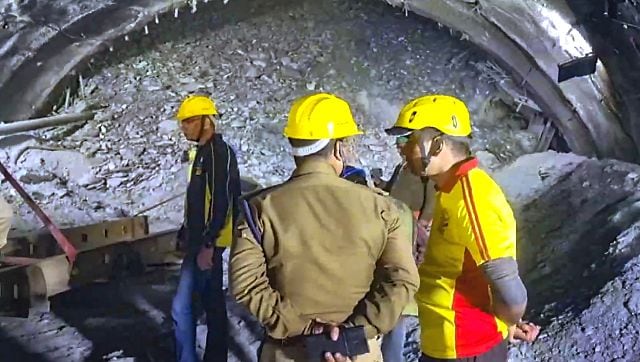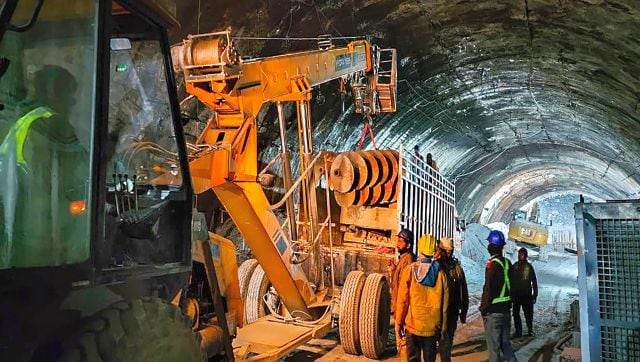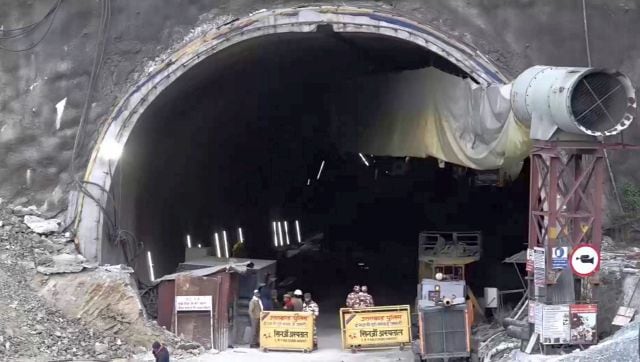Five days and counting. That’s how long 40 labourers have been trapped inside the Uttarkashi tunnel that is being built between Silkyara and Dandalgaon on the Brahmakhal-Yamunotri National Highway. And it seems that the long wait to rescue the trapped labourers is weighing heavy on fellow workers at the site. They staged a protest, shouting ‘Hamare aadmi nikalo (Take out our men..)’, at the site of the accident and where the relief and rescue operation was underway.
The workers and some family members lamented over the absence of an alternative plan and the slow pace of the rescue work as the labourers continued being trapped in the tunnel. But what has led to the delay in getting the trapped labourers out? Why has it taken the officials so long to rescue them? Landslides and loose rocks Forty labourers have been trapped inside the
Uttarkashi tunnel
since Sunday when a landslide caused the tragedy to take place. Since then, authorities have been carrying out ‘rescue efforts’ on a ‘war footing’. The rescue teams have been ensuring that the labourers are as comfortable as possible in such a situation. They have through a
pipe
provided the workers with oxygen and food and on Wednesday even sent medicine to them. However, the rescue plans have been facing delays due to a number of factors. One of the primary issues is the occurrence of a landslide and the loosening of rocks. A fresh landslide took place on Tuesday, hampering operations and also injuring two rescue workers, who have since been moved to a hospital. [caption id=“attachment_13390062” align=“alignnone” width=“640”] Rescue operation teams have been working on a ‘war footing’ to retrieve the trapped labourers from inside the Uttarkashi tunnel. They have been inside the structure since Sunday. PTI[/caption] Dr Sudhir Krishna, former secretary of Union Urban Development ministry, also told NDTV that the Himalayan region comprises soft rocks in general, complicating the operations even further. Echoing similar sentiments, Dr Charu Pant, retired faculty of geology with Kumaun University, told NDTV, “I have been in Silkyara. The rocks there are closely spaced. The zone where this collapse has taken place is a shear zone, meaning the rocks are weak and broken.” What this means is that digging is even more difficult, and this could possibly be on the reasons why rescue operations are being delayed. Technical problems Apart from the landslide and the topography of the area, there’s also the problem of machinery, which is slowing down the rescue operations. On Tuesday, officials began to drill through the debris and install steel pipes using an auger machine, to get the workers out. This method, known as the ‘trenchless technique’ was to put together passages made of mild steel pipes right through the debris so the men can crawl out. However, the auger machine failed on Tuesday, prompting officials to get a new one from Delhi. Explaining what went wrong, an official said that the older machine, brought from Dehradun, could not drill through the rubble; it was unable to cut through the rocks and hence, the decision was made to bring in a newer machine from the Capital. [caption id=“attachment_13390092” align=“alignnone” width=“640”]
Rescue operation teams have been working on a ‘war footing’ to retrieve the trapped labourers from inside the Uttarkashi tunnel. They have been inside the structure since Sunday. PTI[/caption] Dr Sudhir Krishna, former secretary of Union Urban Development ministry, also told NDTV that the Himalayan region comprises soft rocks in general, complicating the operations even further. Echoing similar sentiments, Dr Charu Pant, retired faculty of geology with Kumaun University, told NDTV, “I have been in Silkyara. The rocks there are closely spaced. The zone where this collapse has taken place is a shear zone, meaning the rocks are weak and broken.” What this means is that digging is even more difficult, and this could possibly be on the reasons why rescue operations are being delayed. Technical problems Apart from the landslide and the topography of the area, there’s also the problem of machinery, which is slowing down the rescue operations. On Tuesday, officials began to drill through the debris and install steel pipes using an auger machine, to get the workers out. This method, known as the ‘trenchless technique’ was to put together passages made of mild steel pipes right through the debris so the men can crawl out. However, the auger machine failed on Tuesday, prompting officials to get a new one from Delhi. Explaining what went wrong, an official said that the older machine, brought from Dehradun, could not drill through the rubble; it was unable to cut through the rocks and hence, the decision was made to bring in a newer machine from the Capital. [caption id=“attachment_13390092” align=“alignnone” width=“640”] Rescue operation personnel are installing 800-900 mm diameter pipes through the rubble inside Silkyara tunnel to prepare an escape passage for trapped workers. PTI[/caption] And with a new machine, officials have also decided to adopt a new plan to rescue the trapped labourers. Bhupendra Singh, DGM, Rail Vikas Nigam Limited, told Indian Express, “We are first installing a 125 mm pipe for air, food, camera and communication. That pipe is already 12 metres in. Also, a state-of-the-art, American-made horizontal dry drilling equipment with auger is on its way. “We are almost certain this plan will work. If not, the final option will be using conventional drilling using the pipe roof umbrella method. Under that, we will build an entire tunnel and it will take five-six days as it goes just around 10 metres a day. However, we are sure it will not come to that and the second plan will work,” he said.
Rescue operation personnel are installing 800-900 mm diameter pipes through the rubble inside Silkyara tunnel to prepare an escape passage for trapped workers. PTI[/caption] And with a new machine, officials have also decided to adopt a new plan to rescue the trapped labourers. Bhupendra Singh, DGM, Rail Vikas Nigam Limited, told Indian Express, “We are first installing a 125 mm pipe for air, food, camera and communication. That pipe is already 12 metres in. Also, a state-of-the-art, American-made horizontal dry drilling equipment with auger is on its way. “We are almost certain this plan will work. If not, the final option will be using conventional drilling using the pipe roof umbrella method. Under that, we will build an entire tunnel and it will take five-six days as it goes just around 10 metres a day. However, we are sure it will not come to that and the second plan will work,” he said.
Families Speak As of today, the trapped labourers are safe inside the tunnel. One of the trapped labourers communicated with his son late Monday night and reassured them that they were safe and sound inside. Speaking of his conversation with his father, Akash was quoted as saying, “He mentioned that they are doing well and receiving regular food packets.” But family members continue to be sceptical and wary. Uttarakhand resident Maharaj Singh Negi, whose brother is trapped inside, told Indian Express, “The administration’s efforts are only partially satisfactory. More than 60 hours have passed… We are unable to gain access inside (the tunnel) and are unaware of the steps being taken by the administration. Some people are saying they will be out in a few hours, others say it might take days.” [caption id=“attachment_13390102” align=“alignnone” width=“640”] Security forces personnel guard as rescue work continues after a portion of an under construction tunnel between Silkyara and Dandalgaon on the Brahmakhal-Yamunotri national highway collapsed, in Uttarkashi. PTI[/caption] Questions galore But as the rescue operations continue, experts have also raised pertinent questions and
concerns
. One of the many questions being asked is why did the tunnel cave-in? And experts have a possible answer to this. They state that inadequate investigations prior to the excavation or inappropriate tunnel building protocols could be the likely reasons that could explain the partial collapse of the tunnel. Ravi Chopra, the chairman of the High Power Committee formed by the Supreme Court to conduct the environmental assessment of the Char Dham National Highway project, was also quoted as telling DownToEarth, “Surveys and investigations are both costly and time-consuming. Governments want projects completed with the least amount of money and in the shortest amount of time possible. Incidents like Silkyara are the result of this.” Environmentalists and conservationists also argue that a lot of construction is faulty or done in a haphazard manner, owing to which accidents like the tunnel collapse could take place. Mallika Bhanot, a volunteer with Ganga Avahan, a citizens’ forum in Uttarakhand that has been campaigning for what it describes as responsible development, told The Telegraph, “The tunneling done as part of the project is inconsiderate of the Himalayan environment.” The 4.5-km tunnel is being built to connect Uttarkashi and Yamunotri and is part of Prime Minister Narendra Modi’s
Char Dham project
. With inputs from agencies
Security forces personnel guard as rescue work continues after a portion of an under construction tunnel between Silkyara and Dandalgaon on the Brahmakhal-Yamunotri national highway collapsed, in Uttarkashi. PTI[/caption] Questions galore But as the rescue operations continue, experts have also raised pertinent questions and
concerns
. One of the many questions being asked is why did the tunnel cave-in? And experts have a possible answer to this. They state that inadequate investigations prior to the excavation or inappropriate tunnel building protocols could be the likely reasons that could explain the partial collapse of the tunnel. Ravi Chopra, the chairman of the High Power Committee formed by the Supreme Court to conduct the environmental assessment of the Char Dham National Highway project, was also quoted as telling DownToEarth, “Surveys and investigations are both costly and time-consuming. Governments want projects completed with the least amount of money and in the shortest amount of time possible. Incidents like Silkyara are the result of this.” Environmentalists and conservationists also argue that a lot of construction is faulty or done in a haphazard manner, owing to which accidents like the tunnel collapse could take place. Mallika Bhanot, a volunteer with Ganga Avahan, a citizens’ forum in Uttarakhand that has been campaigning for what it describes as responsible development, told The Telegraph, “The tunneling done as part of the project is inconsiderate of the Himalayan environment.” The 4.5-km tunnel is being built to connect Uttarkashi and Yamunotri and is part of Prime Minister Narendra Modi’s
Char Dham project
. With inputs from agencies
)